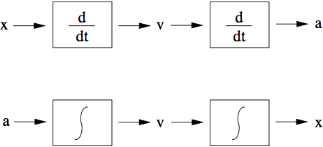Gesture Signal Processing
Filtering
While studying sensors, we discovered that often a particular sensor will measure the position x, velocity v, or acceleration a of an object. However, we might like to use a different variable to control the way we synthesize sound. Ideally, integration and differentiation can be applied to convert between variables.
Here is a simple approximation of an integrator. In this case, we integrate an acceleration measurement in order to obtain velocity. We see that with each time step, v is updated to be nearly the same as the previous v, but it is affected by the input a. This is an example of a low-pass filter because the filter passes mainly low frequencies.
v = 0.1*a + 0.9*v;
Next we show how to approximate a differentiator, so now x represents a measured position, and v represents velocity (although the result is scaled by a constant). The extra variable r is introduced to represent the previous position measurement. Hence, the estimated velocity is the difference between the current position and the previous position. This filter is an example of a high-pass filter because it passes mainly high frequencies.
v = x - r; r = x;
Filter design is an important part of the field of signal processing. For more details, see Julius Smith's book on simple filter design.
Thresholding
Often we want to implement some sort of event detector. For instance, we may want to detect the event that the musician has struck an object such as a drum. If the musician is holding an accelerometer in his or her hand, we can detect the event by waiting for a large value or a large change in the accelerometer signal.
For more details on thresholding, see the threshold and threshold~ objects' help patches in Pd.
